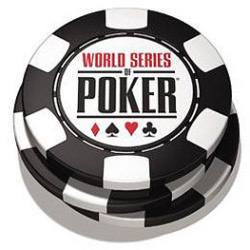Pot-limit Omaha players are getting shortchanged
A few issues ago in my column on the bankroll schedule for pot-limit Omaha, I mentioned that while a typical buy-in for no-limit hold’em might be 100 big blinds, in order to be reasonably deep in pot-limit Omaha, you should buy in for more like 150 times the big blind. In other words, you probably need to be about 50 percent deeper in pot-limit Omaha than in no-limit hold’em in order to be comparably deep-stacked. This makes sense, in that more pots are contested multiway in pot-limit Omaha than in no-limit hold’em, and full pot-sized bets are the standard rather than the exception in pot-limit Omaha.
Yet, with the notable exception of event No. 24 — $2,500 pot-limit hold’em/Omaha — the people who set the structures of the pot-limit Omaha events at the World Series of Poker got it backward:
Pot-Limit Omaha (PLO) Vs. No-Limit Hold’em (NLH) Starting Big Blinds
*Before rebuys and add-ons
**50-75 blinds for pot-limit hold’em round, and 25-50 blinds for pot-limit Omaha round
You see, in the $2,500 pot-limit hold’em/Omaha event, players started with 5,000 in chips with the blinds at 50-75 for the first pot-limit hold’em round and 25-50 for the first pot-limit Omaha round. That works out to about 67 big blinds for pot-limit hold’em and 100 big blinds for pot-limit Omaha — or about 50 percent deeper for PLO than for pot-limit hold’em.
That strikes me as an acknowledgement by WSOP officials that PLO requires deeper stacks in order to be comparable to hold’em. However, outside of that $2,500 mixed pot-limit event, none of the PLO events were comparable to their hold’em counterparts.
For example, the players started 40 big blinds deep (before rebuys and add-ons) in the $1,000 NLH with rebuys event, but only 30 big blinds deep in the $1,500 PLO with rebuys event, in which it probably should have been more like 60 big blinds deep to be comparable — and probably more, considering that the PLO tournament had a higher buy-in. Meanwhile, the $1,500 PLO event was identical to the $1,500 NLH events at 60 big blinds deep. And even the $10,000 pot-limit Omaha event — the biggest PLO tournament around — was only 100 big blinds deep, which was identical to its $10,000 pot-limit hold’em counterpart, and half as deep as the $10,000 NLH main event, in which players started with 200 big blinds.
You might argue that the NLH main event should be 200 big blinds deep because it is the main event; I might buy that argument if the $5,000 NLH event wasn’t 200 big blinds deep, as well.
Now, I am not even going to argue that the WSOP is supposed to be the most prestigious tournament series in poker, and that the PLO tournaments should start off as deep-stacked affairs so that they at least resemble cash-game PLO for a few levels, because that would just be too obvious (PLO is purely bastardized at 60 big blinds deep). However, I would argue that the $1,500 PLO event should start at least 90 big blinds deep and that the rebuy events probably should be at least twice as deep as they are, while the $10,000 PLO event should be at least 150 big blinds deep to be more comparable to its pot-limit hold’em counterpart, if not 300 big blinds deep to be comparable to its NLH counterparts.
ESPN and Event No. 24: $2,500 Pot-Limit Hold’em/Omaha
While we are on the subject of Omaha players getting shortchanged at the WSOP, ESPN made an interesting decision: ESPN360.com was originally scheduled to feature the final table of the $2,500 pot-limit hold’em/Omaha event on World Series of Poker Live, but instead pushed aside the mixed pot-limit event in favor of the final table of a $2,000 buy-in no-limit hold’em tournament.
This is a little hard to figure, as there weren’t a lot of (if any) big-name players in the $2,000 no-limit event. In contrast, the mixed pot-limit final table included Allen Cunningham, Minh Ly, and eventual champion Max Pescatori, not to mention some strong young all-around poker talent, including 21-year-old Lennart Holtkamp from the Netherlands and 26-year-old online player Jonathan Depa from Indiana. And one of the things missed was the breakout performance of the second-place finisher, 24-year-old Kyle Kloeckner from St. Louis.
Now, if you ask Kyle, he’ll tell you that hold’em is his best game. But at a final table with some pretty good hold’em players, I thought Kyle had an edge in PLO, a game that he plays with some pretty tough competition in our regular, sometimes-wild $5-$10 (sometimes $20 straddle) game in St. Louis. And Kyle also plays $25-$25-$50 and bigger during tournament time.
Kyle went to the final table as the chip leader, and wound up taking home $152,410 for his second-place finish. And then, less than a week later, Kyle went to the final table of the $1,500 PLO with rebuys event as the chip leader, and wound up placing sixth for $114,338. Layne Flack won that event.
High Stakes Poker: PLO?
I was a bit surprised when I heard that GSN had yet to pick up another year of High Stakes Poker, but watching the early rounds of the $5,000 PLO with rebuys event, it became clear that the show needs to go on.
It also became clear that a little PLO on the show would be wildly entertaining.
Early on in the tournament, there was a stacked table that featured Daniel Negreanu, Phil Hellmuth, Robert Williamson III, Erik Seidel, Daniel Alaei, and Erick Lindgren; that is a pretty sick lineup worthy of High Stakes Poker. In one hand, Negreanu — on, I think, somewhere between his fourth and 15th rebuy — got all in preflop against both Seidel and Williamson. Negreanu had something like K-9-6-3 (suited), Seidel had A-A-J-3 with a suit, and Williamson had A-A-J-6 with suited spades. The flop came K-10-10 with two spades, giving Williamson a gutshot and the nut spade draw. A 7 hit the turn, giving Negreanu a straight draw, and then a king on the river gave Negreanu trips for the scoop.
I turned around, and Patrik Antonius was in a three-way pot, all in on the flop. The flop came something like Q 7
7




















I was entertained.
So, I guess the real question is: Who wouldn’t want to see our stars gamble it up in a little game of High Stakes Poker, PLO style?
This article was originally written by Jeff Hwang. Jeff Hwang is a semiprofessional player and author of Pot-Limit Omaha Poker: The Big Play Strategy. His latest book is Advanced Pot Limit Omaha Vol.1 and will be releasing Vol 2.
Submit your review | |



